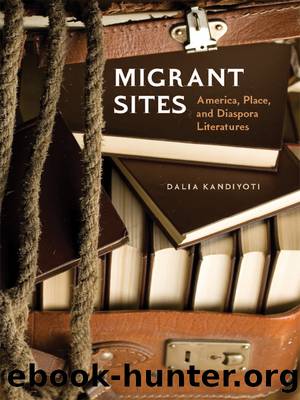Migrant Sites by Kandiyoti Dalia;

Author:Kandiyoti, Dalia;
Language: eng
Format: epub
ISBN: 1084890
Publisher: University Press of New England
Published: 2009-08-15T00:00:00+00:00
THE PLACES OF CHICANA/O LITERATURE
In Chicana/o cultural productions, the politics and aesthetics of place are inextricably locked together, as is befitting a literature that flowered at the very same time as a class-and ethnicity-based political movement. Writing in 1980, prominent literary historian Bruce-Novoa noted that the ârecent phenomenonâ of Chicano literature was âa by-product of the Chicano Movementâ (Chicano Authors 4), and anthropologist José Limón emphasizes that it is âimpossible to conceive of the Chicano movement from 1965 to 1972 without its artistic literature, particularly, its poetryâ (84). While Chicana/o politics has changed significantly, the poetics of place and displacement remain interwoven and persist in constituting a core problematic of Chicana/o writing and politics.
The historical dispossession of the annexed Mexicans, the continued border-crossing of peoples under quasi-colonial conditions of economic dependence, and the exploitation of ethnoracialized subjects as disposable, cheap labor in the United States and Mexicoâas well as resistance, rebellion, and folk, experimental, literary, and popular cultural traditions as founts of resistance and rebellion spanning bordersâare the backbones of Chicana/o history and literature. The authorsâ treatment of spatialized coloniality is informed by this Chicana/o history and culture, which are deployed as challenges. Specifically, while Portillo Trambley and Cisneros depict very restricted settings of small towns, they draw on the love of land, Aztlán, and the borderlands topoi of Chicana/o literature to take their stories out of their own boundaries, as it were. The enclosures of gender, race, and class are mediated by other spatialities that feed the âdecolonial imaginaryâ (Pérez).
At the center of this imaginary is the awareness of the role of U.S.-Mexico relations in shaping Chicana/o lives and literatures; specifically, the impact of the U.S. pursuit of empire in Mexico and the domestic production of conquest and expansion through the exploitation, marginalization, and demonization of immigrants. U.S. expansion did not end with the wars, treaties, and purchases of the 1840s but has continued to inform the Mexican economy and politics, from the Mexican Revolution to NAFTA (North American Free Trade Agreement). The removal of President Lerdo to install Porfirio DÃaz, which resulted in the phenomenal spread of U.S. investments in Mexico, was the first instance of a U.S.-supported overthrow of an elected government; as historians have explained, the Revolution was the âfirst major political challenge to American hegemony in Latin America during the modern eraâ (Hart 68, 303). Since 1848, the continuing hegemonic practices of the United States over Mexico have shaped the fate of the Mexican diaspora in the U.S. territory, with Mexican-origin populations experiencing segregation and proletarianization (especially in California and Texas), as well as, more recently, âillegality,â incarceration and deportation, even though their labor is necessary and their most recent migrations in great part a consequence of NAFTA (see, for example, Horsman, David Gutiérrez). Both the legacy of the dispossessed annexed Mexicans of 1848 and the migrations that have been largely the fallout of this imperial relationship characterize the spatial discourses of Chicana/o literature. The spatializations of land, Aztlán, and the borderlands contribute, in different
Download
This site does not store any files on its server. We only index and link to content provided by other sites. Please contact the content providers to delete copyright contents if any and email us, we'll remove relevant links or contents immediately.
Cecilia; Or, Memoirs of an Heiress — Volume 1 by Fanny Burney(32028)
Cecilia; Or, Memoirs of an Heiress — Volume 3 by Fanny Burney(31439)
Cecilia; Or, Memoirs of an Heiress — Volume 2 by Fanny Burney(31388)
The Great Music City by Andrea Baker(30761)
We're Going to Need More Wine by Gabrielle Union(18609)
All the Missing Girls by Megan Miranda(14629)
Pimp by Iceberg Slim(13756)
Bombshells: Glamour Girls of a Lifetime by Sullivan Steve(13668)
Fifty Shades Freed by E L James(12890)
Talking to Strangers by Malcolm Gladwell(12828)
Norse Mythology by Gaiman Neil(12794)
For the Love of Europe by Rick Steves(11341)
Crazy Rich Asians by Kevin Kwan(8866)
Mindhunter: Inside the FBI's Elite Serial Crime Unit by John E. Douglas & Mark Olshaker(8669)
The Lost Art of Listening by Michael P. Nichols(7140)
Enlightenment Now: The Case for Reason, Science, Humanism, and Progress by Steven Pinker(6856)
The Four Agreements by Don Miguel Ruiz(6291)
Bad Blood by John Carreyrou(6259)
Weapons of Math Destruction by Cathy O'Neil(5805)
